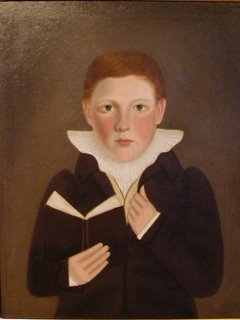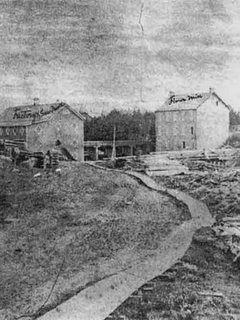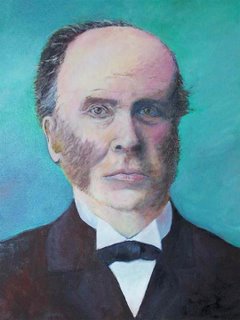Tuesday, November 22, 2005
Moss Kent's Father, Barnabus Dickinson

They came from the New England States, and their ancestors came to North America on that crowded little ship, the Mayflower.
In 1812, Barnabus and Lydia, left their home in Denmark, New York and came to Canada.
Barnabus started a stagecoach service, from Montreal to Kingston. Some time later, he left the business with his brother, Horace and they returned to Denmark.
Barnabus started a stagecoach service, from Montreal to Kingston. Some time later, he left the business with his brother, Horace and they returned to Denmark.
Moss, the Young Man

In 1828, the family returned to Canada, and Barnabus expanded the transportation business, to include, not only the stagecoach part, from Montreal to Dickinson Landing, but also, to go by steamer, from there through to Kingston.
( Dickinson Landing was named for Barnabus)
( Dickinson Landing was named for Barnabus)
In 1832, Moss and his father, attended the opening of the Rideau Canal, in Kingston. They met Colonel John By and also a Trigge family from England. Their Daughter Elizabeth, was 10 years old, at the time.
In 1833, Barnabus succumbed to cholera, which was raging among the canal workers, at the time. Lydia, his widow, moved the family to Prescott and her eldest son, continued the business. Moss attended school there and in Cornwall, subsequently returning to Denmark, to complete his business training at an Academy. By the time he was 16, he was employed as a clerk. (The town of Denmark no longer exists; it would doubtless be thriving today if Moss had stayed there).
Partnership with Joseph Currier

They leased the water rights from the government and hired Thomas Langrell, an Ottawa contractor, to build the grist mill.
Water Power

Mill Tragedy (photo: grist mill)

In 1864, when Moss was 42, he became Mayor of Ottawa. Among his achievements were the construction of a horse drawn, 20 passenger tram car service, which operated on rails for 4 miles across the city, and placing the city on a secure financial basis. He served for two terms of one year, but declined to run for a third.
Mayor and Businessman (image: mill flyer)

When Moss was 48, he sold his forwarding company, probably at a considerable loss. He was losing business to steam trains.
Moss did not re-marry. His youngest daughter Lydia, died when she was 12. About this time, he moved his family to Manotick, into a new house, which he had had built, the present day Dickinson House. The front portion was a store which supplied dry goods, groceries hardware and agricultural instruments. Later his son, George ran the post office in that section. The back part with an extension, no longer there, was the living quarters.
Between ages 50 and 57, Moss owned: 160 village lots; 14 commercial lots; 18 hydraulic lots; a saw mill; a grist mill; a bung mill; and a carding and cloth factory. He was truly an entrepreneur.
Political Career

When Moss was 66 years old, in 1882, he became an MP, winning the Conservative seat for Russell. He was typical of 19th century MP’s from Ontario, in that he was Protestant ( Moss was a Presbyterian) , he was a business man ( in lumbering and milling) and he was fairly well-to-do. However, he was not really representative of his rural constituents. He seldom spoke in Parliament, being more a man of action, but he did serve on several committees, such as, Railways canals and telegraph. He probably hoped that being an MP might help him in his financial distress.
He became friendly with Sir John A MacDonald, who conducted one of his campaigns from Dickinson House. Sir John also addressed a large rally from the saw mill, the biggest building in town.
Losses (photo: mill prior to 1921 fire)

Moss’s financial situation was becoming more and more precarious. Collateral for loans in the 19th century, was land, not businesses. This made it hard for Moss, who did not own much land. Also business operated largely on credit. After1865, his Manotick properties were never free of mortgages. Grist mills, were being superseded by roller mills. ( A grist mill in Ottawa, advertised for 130,000 dollars, finally sold for only 85,000 dollars.)
The saw mill burnt down. The Americans raised the duties on Canadian lumber. There was a depression. Moss borrowed from friends and finally 40,000 dollars from a Toronto bank. He was pushed to make payments on the Toronto loan and could not.
The saw mill burnt down. The Americans raised the duties on Canadian lumber. There was a depression. Moss borrowed from friends and finally 40,000 dollars from a Toronto bank. He was pushed to make payments on the Toronto loan and could not.
Son George, was allowed to lease the mill, and the house, and was able to keep them operating. What to do? The country was opening up and lumber would be required. Moss and George applied to the ministry of the interior, for timber limits in the North West Territories. George acquired 50 square miles at the Berens river, in Manitoba, and Moss obtained 50 Square miles at the Little Swan river, in Saskatchewan. Before the business could become operational, a legal inspection had to be made. Moss, no longer a young man, traveled to Winnipeg, with a lawyer, and then north to the holdings. There were impediments, a fire, lack of affordable transport, and legal problems, so the enterprise did not ‘get off the ground’.
Final Resting Place: Beechwood Cemetary

When he was 71, still trying, he acquired an interest in a mill site on the Red Deer river.
He hoped to sell it at a profit, to apply to his debts. It came to naught. In1897 on July the 19th Moss Kent died at the age of 75, owning nothing. He had held off his creditors for 20 years. No mean feat! However, George and William were able to carry on until 1928, when they both died.
Charlotte died in 1927 and Elizabeth sold the house to Aleck Spratt and moved to Ottawa to live with a cousin, in 1929. None of the children married and there are no longer any Dickinsons’ in Manotick, but the legacy of Moss Kent Dickinson, is the village, his dream.
In 1891 when Moss was 69, he tried to get the proposed railway, which was to run from Kingston to Ottawa, routed through Manotick, which would have enhanced property values. Marlborough and North Gower were able to prevent that happening. When he was 71, still trying, he acquired an interest in a mill site on the Red Deer river.
He hoped to sell it at a profit, to apply to his debts. It came to naught.
In1897 on July the 19th Moss Kent died at the age of 75, owning nothing. He had held off his creditors for 20 years. No mean feat! However, George and William were able to carry on until 1928, when they both died. Charlotte died in 1927 and Elizabeth sold the house to Aleck Spratt and moved to Ottawa to live with a cousin, in 1929.
None of the children married and there are no longer any Dickinsons’ in Manotick, but the legacy of Moss Kent Kent Dickinson, is the village, his dream.





